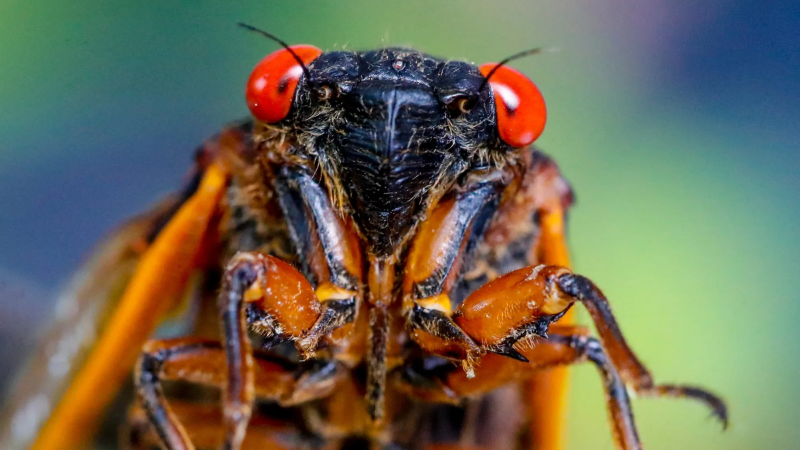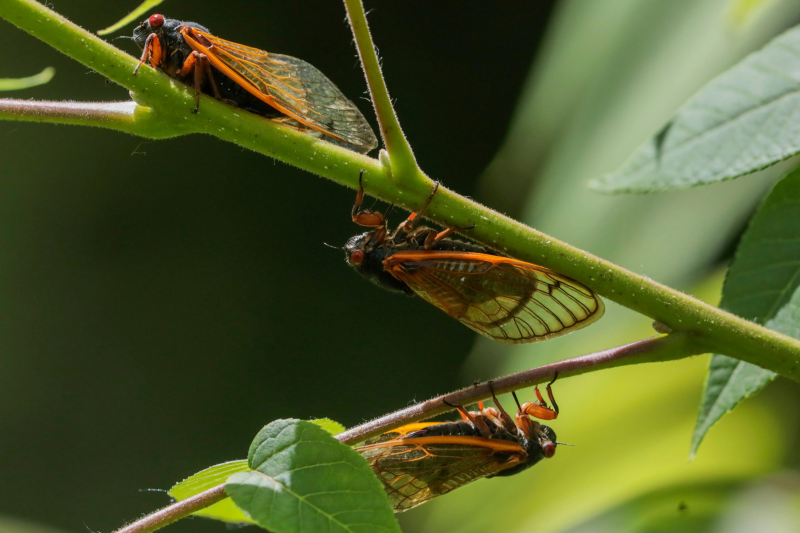The cicada invasion has begun. Experts recommend greeting it with awe, curiosity and humor
Much of the middle and southern part of the country is bracing for a rare dual-emergence of two gigantic cicada broods, Brood XIX and Brood XIII, some which have already been spotted by people in Georgia, North Carolina, South Carolina, Alabama, Mississippi, Tennessee, Arkansas, Kentucky and Missouri.
While some fear or dread the insect invasion, scientists say it's a fascinating, spectacular occurrence that shows the great dance of nature at its most exceptional.
The two broods appear at different intervals: every 13 and every 17 years and overlap between them is rare. Cicadas are short-lived and will only be around for about six weeks. And they only emerge from underground when the surface temperatures reach 64 degrees, which is happening now.
Scientists are greeting the phenomenon with a mix of awe, curiosity and humor — and they hope Americans will too.
“They're sort of goofy. They’re not super great flyers and they’re kind of awkward when they land. They don’t bite, they’re not poisonous. If your pet eats one it’s not going to harm them. They’re totally harmless to humans and domestic animals,” said Floyd Shockley, co-lead of the entomology department at the Smithsonian Institution’s National Museum of Natural History.
Shockley said the next few weeks will be “a natural phenomenon that other people in the world would be jealous to see."
Here's a look at why scientists are so in awe of cicadas, and what you can do to enjoy this noisy natural phenomenon.
A mind-boggling number of bugs
The sheer volume of cicadas that will emerge will be enormous, experts say.
“The total number of cicadas that will emerge in the United States between the two broods will be in the many billions, said Gene Kritsky, an emeritus professor of biology at Mount St. Joseph University in Ohio and the author of “A Tale of Two Broods: The 2024 Emergence of Periodical Cicada Broods XIII and XIX.”
It could go as high as a trillion, said Shockley.
When will cicadas come back?You're asking the wrong question. Their pee will 'rain' down
“It is certainly conceivable,” he said. “But remember that’s spread across about 19 states. In areas of local abundance, it will be millions to billions and then there will be other areas where there’s been habitat destruction from agriculture and urban spread it could be lower.”
For those who live in cicada-dense areas, it will be a lot of insects. “There could be thousands in your backyard,” Shockley said.
Evolution offers a fascinating reason for the hordes of cicadas
It's a survival tactic called "predator satiation." There are so many of them that even the hungriest predators can't eat them all.
“They’re eaten by mammals, birds, insects, and even a few people. But you’re never going to be able to impact the entire population because they come out in such large numbers,” said Shockley.
Sometimes a few cicadas in a brood hatch at the wrong time, known in the scientific literature as "stragglers" but they usually don't survive to reproduce.

A genetics experiment that will take a decade to unfold
Because the two broods exist on different timetables, every 13 and every 17 years, they don’t overlap very often — 221 years ago to be precise.
“It’s an exciting thing – the last was in 1803,” said Kritsky.
Will these different broods interbreed? Today's grad students are gearing up to study the answer, which probably won't come until at least 2037.
The area of overlap between the broods is very small, only a few counties in Illinois, so there won’t be a huge opportunity.
In general, broods don’t interbreed. While they can be forced to do so in the lab, in nature they don’t, mostly because they’re mating at different times. But with two broods emerging at the same time and with a small overlap, some interbreeding could possibly occur – scientists are curious to see what happens but resigned to waiting to find out.

“If you’ve got one 13-year cicada and one 17-year cicada and they mate, what are they going to be? We just won’t know until at least 13 years,” said Shockley.
“We’ve got the opportunity for either a new brood altogether, which is very rare, or they could join with an existing brood,” he said.
Two nearly identical species with real differences
To tell the difference between the two types of cicadas, you need a special tool called an oscilloscope.
Both 13- and 17-year cicadas look pretty much the same and to most people they sound the same, even producing the same volume of sound.
But the frequency, pitch and tone of the males' mating song (females do not sing) can be slightly different, something scientists who study them can often identify on recordings.
To really make an identification requires an oscilloscope, a scientific instrument that graphically shows the intensity of sound, measuring frequency, wavelength and amplitude.
"That’s the most accurate way to tell the species apart,” said Shockley.
Are humans harming cicadas?
Humans are definitely cutting into the areas where cicadas can live, said Kritsky.
“Their distribution becomes very patchy because of clear-cutting (of trees) for agriculture and urban development,” he said.
It's also not immediately visible because of their long time underground.
“A lot can change over 13 or 17 years in a particular area,” said Shockley. “Cicadas aren’t very good at digging through concrete – you lay a parking lot down and they’re not coming back.”
Kritsky started studying cicadas in the 1970s and has seen up close and personal what can happen when the trees the insects rely on disappear.
“I studied a development in the 1990s where they clear-cut all the trees. Then in 2004, when brood X emerged, not a single cicada emerged in that area,” he said.
Cicadas boost the ecosystem after they die (and won't harm your garden)
Cicadas offer a wonderful example of a beneficial ecological system. For 13 or 17 years the juvenile cicadas, called nymphs, live underground, feeding off the sap of tree roots. They can burrow as much as two feet underground to find a good place to eat and go through the majority of their life cycle.
“That's why they only emerge from under trees,” said Kritsky.
Once the cicadas die, about six weeks after emerging, there will be “a substantial amount of corpses laying around,” said Shockley. These decompose quickly, a natural process that's good for vegetation.
“The trees feed the cicadas when they’re nymphs and then when the cicadas break down they give back nutrients to nourish the next generation. It’s a really beautiful system,” said Shockley.
Beware the cicada killer:2024 broods will need to watch out for this murderous wasp
Experts say your garden has nothing to fear from cicadas either.
The cicadas “prune” mature trees but don’t harm them. They don’t eat flowers or vegetables. Pretty much the only part of the yard that could possibly hurt would be young, new trees, said Kritsky.
For those with newly planted trees, garden stores sell mesh that can go over them to protect them.
“As long as the cicadas can’t get their mouth parts over the surface of the stems, they can’t harm them,” said Shockley.
Experts say trying to poison cicadas will backfire
There’s no reason to be scared of cicadas and no need to overreact, say experts who spend lots of time with them.
Most importantly, don’t buy pesticides and spray your backyard to get rid of them.
“First because they’re harmless and second because it’s not going to work,” said Shockley. “You could spray every inch of your yard and it wouldn’t matter because they’ll be back the next day."
Not only that, but animals will eat the dead cicadas, so you’d be poisoning a lot more than just cicadas.
Studying cicadas links generations of researchers
You can’t have a short attention span if you research cicadas. “I‘ve waited as long as 17 years for an experiment to come to fruition,” said Kritsky.
Any researcher who studies them has to have patience. There's a reason many researchers work with fruit flies, because with a lifespan that can be as little as two weeks, it's possible to breed hundreds of generations over the course of an experiment.
Cicadas are an entirely different story.
“You get one or two cycles in and then you’re done with your career. It’s got to be intergenerational study,” Shockley said.
Disclaimer: The copyright of this article belongs to the original author. Reposting this article is solely for the purpose of information dissemination and does not constitute any investment advice. If there is any infringement, please contact us immediately. We will make corrections or deletions as necessary. Thank you.






